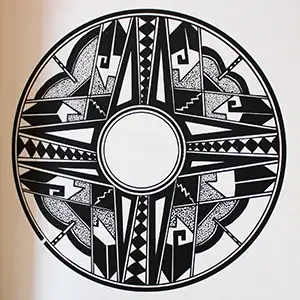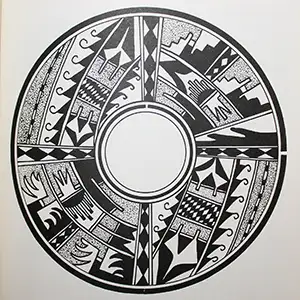Payupki

A Payupki Polychrome bowl
The Rio Grande pueblos were in turmoil after the success of the Pueblo Revolt of 1680. That turmoil was aggravated every time the Spanish came back, and they came back in 1681, 1682, 1684, 1688 and 1692, each time attacking and burning the Tiwa pueblo at Alameda. They also attacked the pueblos of Santa Ana and Zia on most of their incursions. It didn't help either that the other pueblos assumed that the Tiwa had been friends of the Spanish because the Spanish stopped at Alameda in their retreat from Santa Fe in 1680. Of course, as the Spanish retreated from New Mexico, they took prisoners and loot and burned the pueblos as they were passing by.
Nearly the entire population of Isleta was taken south by the retreating Spaniards. Many of those formed a pueblo at Ysleta del Sur (now inside the city limits of El Paso, TX). Some of them escaped and headed back north. Others had escaped earlier and not made the journey south. They banded together with other Tiwa speakers from the middle Rio Grande Valley and made the journey to Tusayan.
In the aftermath of the Pueblo Revolt and after each succeeding attack, whole clans and families, Tewa, Tiwa, Towa and Keresan, left the Rio Grande Valley and made the journey to the Hopi mesas where they hoped to be beyond Spanish control. And some of them were, for more than 60 years. Then the Franciscans came back.
On the Hopi mesas, some of the Towa-speaking migrants found shelter and merged into Awatovi. Others were given land and allowed to build a pueblo on a northern finger of Second Mesa. These were people from Zia, Santa Ana, Santo Domingo, Laguna and Acoma (all Keresans) and the southern Tiwa pueblos (Sandia and Isleta). Today's Hopi say they named the pueblo Payupki, River House. Construction began in the early 1680s and continued for about 20 years as new families and clans arrived. The Spanish finally succeeded in reconquering the pueblos in New Mexico in 1696 and that put an end to most people leaving the Rio Grande area. Only the Southern Tewas left en masse after that and they settled at Hano on First Mesa.
The Spanish authorities in Santa Fe had no interest in sending troops on a long march across the desert to Tusayan, they had enough problems to deal with in New Mexico. The Franciscan fathers, though, they couldn't let it go. Around 1698 a group of Franciscans and a few soldiers arrived at Awatovi to rebuild the mission. The people of Awatovi may have welcomed them but the other Hopi pueblos were significantly more hostile this time around. It led to the destruction of Awatovi in the winter of 1700-1701. Awatovi was primarily occupied by people speaking Towa and (what became) Western Keres.
In the early 1740s, a couple missionaries made the trek to find where the other missing Puebloans went to and try to convince them to come back. Their timing was good: there was strife happening between the people of Payupki and the nearby Hopi settlements of Mishongnovi and Shipaulovi. The padres were able to convince most of the Tiwas that it was time. That was the beginning of the end as the remaining people slowly moved to First Mesa or returned to the Rio Grande. By 1780 Payupki was completely abandoned. It has never been reoccupied. The Payupki style of pottery and design was prevalent around the Hopi mesas from about 1680 to about 1780. With the abandonment of Payuki most pottery production shifted to the First Mesa area and the conversion to what is called Polacca Polychrome A began.
Around Payupki, the migrant potters seem to have learned about the local clays and fuels from other potters in the area. They adapted and got really good at their craft. They made a lot of pottery, so much pottery that the ground around their ancient ruin is still littered with pot sherds everywhere. The potters of Payupki evolved their own styles and design vocabulary. Payupki design patterns were in extensive use around the Hopi mesas up until about 1780. Those designs have now been entered into the Hopi lexicon as "Sikyátki" designs, primarily because they were used by Nampeyo of Hano in the late 1800s and early 1900s.
The potters of Payupki also seem to have used a puki similar to that used by many Zuni potters. The puki provides support for the bottom of a pot as it is being coiled. It's likely a descendant of the perforated plates that were carried south by the Kayenta potters who formed the basis of the Salado phenomenon in the 1100s and 1200s. There's little known about the migration from the Rio Grande Valley to Payupki but it appears that some of them stopped at Zuni for a few years along the way. Most of the Eastern Keresans made the trek through Gobernador Canyon and along the Upper San Juan before turning southwest and heading for the Hopi mesas. Near ancient pueblos in Gobernador Canyon there were several complete pots found, pots most likely made by potters from Zia during a layover in their move to Hopiland. Those pots comprise the type known as "Puname."
It was pretty customary in those days for long journeys to be made between known water sources. Sometimes a group would stop for months, planting and harvesting a crop or two before moving on. Sometimes that stop might be for several years, and they'd build some kind of structure on the spot. Sometimes pregnant women would layover at a pueblo along the way until they were ready to travel again. Sometimes the ritual specialists accompanying a clan migration might be invited to stay somewhere along the way, too.
In 1742, the Southern Tiwas were led back to the environs of Albuquerque by a group of Franciscan fathers. That journey was over in a couple months. Then it was years before the folks from Alameda Pueblo were allowed to rebuild at Sandia because, as indefensible and uninhabitable as Alameda was, it provided Albuquerque with a good front line of defense against marauding Navajos, Apaches and Comanches. Sandia was in a more defensible position and was out of the marauders' traffic pattern. They were finally given permission to build a new pueblo at Sandia about a decade before Governor Juan Bautista de Anza took his troops and several cohorts of Pueblo warriors north with him through the San Luis Valley, around Pikes Peak and down the Front Range to Greenhorn Mountain. In the foothills of Greenhorn Mountain they stumbled across a large Comanche war party headed toward New Mexico and were able to wipe out virtually the entire Comanche high command in a couple hours of fighting. The leader of that war party: Cuerno Verde, so named for the buffalo head with green-dyed horns that he wore as a war bonnet. That's where a lot of names local to that area of Colorado came from.
Neither Sandia nor Isleta pottery has reached that quality or plethora of designs and styles since they left Payupki. Those who had gone south with the Spanish in 1680 and returned years later didn't fare any better: the Southern Tiwa pottery tradition was essentially broken.
In their return to the Eastern Keresan pueblos, the potters retained their skills but essentially dropped all their Payupki design patterns and merged into the prevalent styles local to their pueblos.
But when you see a Hopi pot with a geometric design pattern on a jar that is clearly broken into panels by vertical lines, or by crossed lines in the bottom of a bowl, you're looking at a design pattern pioneered by the potters of Payupki.
Sites of the Ancients and approximate dates of occupation:
Atsinna : 1275-1350
Awat'ovi : 1200-1701
Aztec : 1100-1275
Bandelier : 1200-1500
Betatakin : 1275-1300
Casa Malpais : 1260-1420
Chaco Canyon : 850-1145
Fourmile Ranch : 1276-1450
Giusewa : 1560-1680
Hawikuh : 1400-1680
Homol'ovi : 1100-1400
Hovenweep : 50-1350
Jeddito : 800-1700
Kawaika'a : 1375-1580
Kuaua : 325-1580
Mesa Verde : 600-1275
Montezuma Castle : 1200-1400
Payupki : 1680-1745
Poshuouingeh : 1375-1500
Pottery Mound : 1320-1550
Puyé : 1200-1580
Snaketown : 300 BCE-1050
Tonto Basin : 700-1450
Tuzigoot : 1125-1400
Wupatki/Wukoki : 500-1225
Wupatupqa : 1100-1250
Yucca House : 1100-1275

